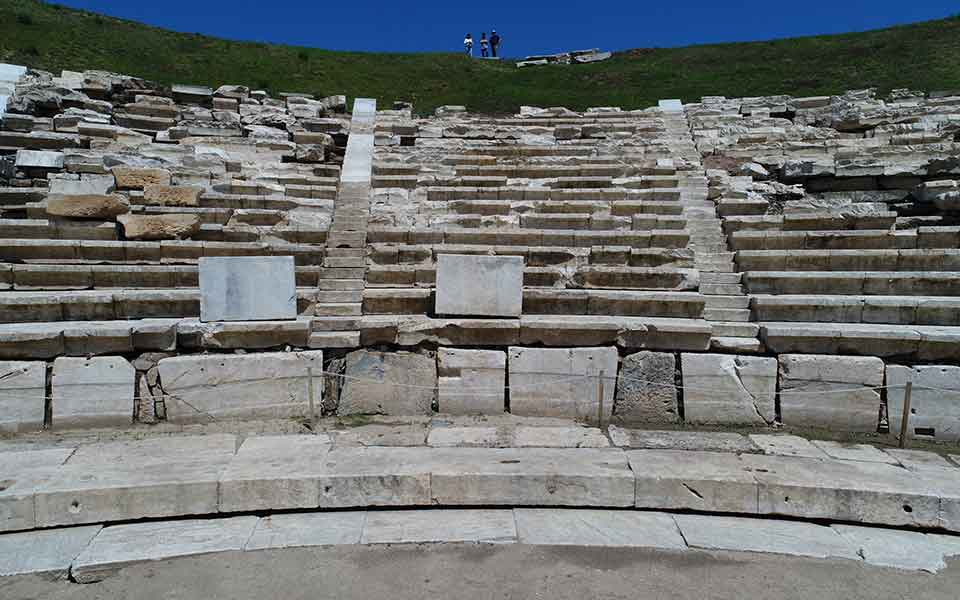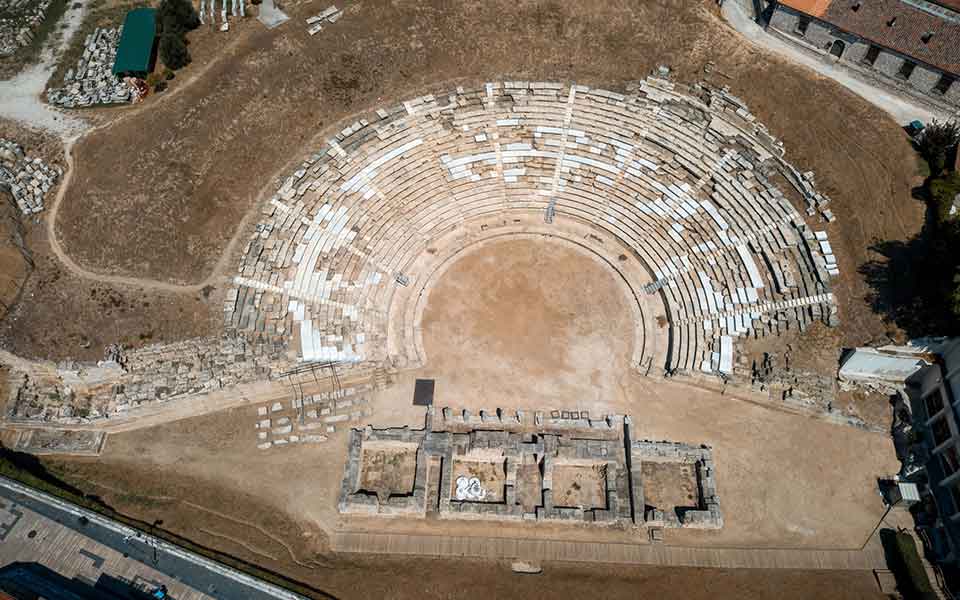The excavation and conservation of the ancient theatre of Larissa is one of the most important achievements of modern archaeology: an outstanding example of how the recovery of an ancient monument can impact upon the identity of a modern city.
A masterpiece of Hellenistic architecture, with an orchestra diameter of 25m, 11 stands and 24 rows of seats, the ancient theater was unearthed in the center of Larissa, in the heart of Thessaly. Now, advanced work will allow public access to its seats.
The project to unearth the theater began gradually in the 1980s and 1990s, at the initiative of Greece’s Ministry of Culture, under the direction of the curators of antiquities Costas Gallis and Athanasios Tziafalias. Since 2002, when the conservation of the monument began, through community support frameworks, the theater has become an iconic landmark in the city – Thessaly’s answer to the world-famous Ancient Theater of Epidaurus, in the Argolid.
The Roman phase
“The present restoration program, through which the seats have now taken their final place, was made possible thanks to the restoration study carried out with funding from “Diazoma” and the Municipality of Larissa,” says the head of the Ephorate of Antiquities of Larissa, Stavroula Sdrolia, who supervises all the works on the monument together with a five-member team.
“According to this study, the monument is being restored to its Roman phase, during which time the three lower rows of seats were removed to protect spectators when it functioned as an arena. The project is implemented by the Ephorate of Antiquities of Larissa, with funds from the Region of Thessaly, through the NSRF 2014-20. In achieving it, many difficulties were encountered, due to the great stress that the monument has undergone throughout its long history, and required concerted efforts by specialized and dedicated staff, conservators, craftsmen, engineers and archaeologists,” she added.

© Ephorate of Antiquities of Larissa / Hellenic Ministry of Culture and Sports
Today, the Ephorate of Antiquities of Larissa has announced the completion of the project for the placement of the new marble seats in the cavea (seating section). For most of them, the original location has been located, as there were engraved inscriptions on the marble with the names of the ancient Larissans to whom these places belonged, according to Diazoma, an Athens-based cultural organization dedicated to the protection and conservation of ancient theaters.
The project is now in its final phase, as tenders are underway for the restoration of the 35m-long stage building, which bears on the façade the “proscenium,” an arcade of marble columns with three entrances. “The largest part of the architrave, which bears inscriptions from the 1st century AD, is preserved from the proscenium, in honor of Octavian Augustus, the first emperor of Rome, and his successor, Tiberius,” notes Sdrolia.
What is impressive is that the ancient theater was entirely buried under the asphalt and modern buildings. Its gradual excavation, which continues for adjacent buildings, is an extraordinary story of a monument reshaping the image, identity and perspective of a modern city. The theatre has already changed Larissa, as it is located where the pulse of the city beats, on Venizelos Street, near the Fortress, the shops, the modern cafes, the central square and the hotels. It is perhaps a unique case of ancient theater coming back to life to broaden and improve the identity of a city. The Municipality of Larissa and the Region of Thessaly consider the operation of the theater as the trigger of a new phase of development of the city, but also of the whole region.
The integration of the theater into the functioning of the city has brought to the fore a number of key issues. Larissa, a city that has lost much of its modern urban memory, is currently facing the challenge of acquiring a wider historical center with the Fortress, the Bezesteni (Ottoman-era market), other Ottoman monuments, the theater, and the architectural fabric of the old commercial center. Streets such as Apollonos, which runs along the axis of the theater, have taken on a special atmosphere. The current project offers an opportunity to predict the form of the city center in the long run while preserving its historical stratigraphy. The contribution of the Association of Architects of Larissa is also important, taking a position on many issues of the city.
Furthermore, Larissa has the opportunity and potential to arouse international interest and create conditions for a major regional metropolis in the heart of Greece.
This article was previously published in Greek at kathimerini.gr.












